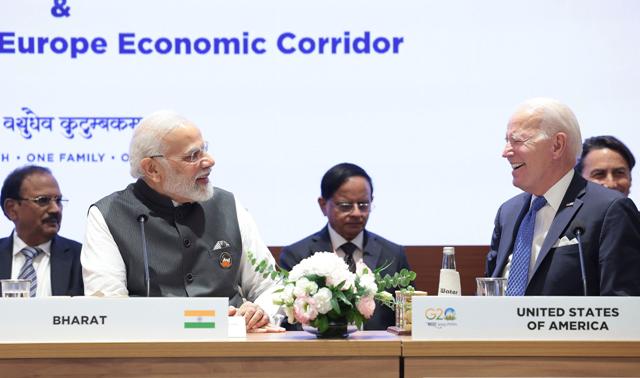 9th Sep, 2023: Indian Prime Minister Narendra and US President Joe Biden at the Partnership for Global Infrastructure and Investment & India-Middle East-Europe Economics Corridor event during the G20 Summit in New Delhi. [Photo: PIB/Press Information Bureau/ Alamy Live News]
9th Sep, 2023: Indian Prime Minister Narendra and US President Joe Biden at the Partnership for Global Infrastructure and Investment & India-Middle East-Europe Economics Corridor event during the G20 Summit in New Delhi. [Photo: PIB/Press Information Bureau/ Alamy Live News]
The names of Indian cities such as Mumbai, Chennai and Bengaluru are regularly being changed to reflect aspects of their history or to emphasise their regional role. No-one however was ready for the big surprise that Prime Minister Narendra Modi produced on the eve of recent G20 summit when his government began, without any warning or discussion, what looks like a process to emphasise Bharat rather than India as the name of the world’s most populous country.
Bharat means India in Hindi and other Indian languages and it had appeared in names of new buildings that housed the summit. That had not attracted any attention because it is widely used, both formally and in spoken and written Hindi.
Social media was activated with a picture of an invitation from the “President of Bharat”, not the usual India, to the formal G20 banquet on September 9. It then emerged that the name was already in a booklet for visiting G20 delegates titled “Bharat, The Mother of Democracy”, which said, “Bharat is the official name of the country. It is mentioned in the Constitution as also in the discussions of 1946-48”.
Forecasting India’s potential
India’s foreign policy: nationalist aspirations and enduring constraints
It would be a massive exercise, with international ramifications, to make a complete change from India to Bharat, but suggestions that this could be a just a temporary move seemed to be confounded when the country name card in front of Modi at G20 sessions last weekend said “Bharat”.
Both names have roots deep in history. Bharat is the older. According to tradition ‘Bharata’ the ancient name for the Indian subcontinent, was derived from King Bharata, one of the key ancestral figures in the foundational Indian epic ‘The Mahabharata’, a major Sanskrit account of ancient India revered in Hinduism. India has origins with the Indus civilisation but has more colonial associations.
Soon after the country’s independence, leaders debated between the two names along with Hindustan (land of the Hindus). Under Jawaharal Nehru, the westernised prime minister, India prevailed even though the national anthem, composed by the famous poet Rabindranath Tagore in 1905 , does not contain the word India at all but begins with “Bharat Bhagya Bidhata” (Dispenser of Bharat’s destiny).
The country’s Constitution says “India, that is Bharat, shall be a union of states”, but that is the only time Bharat appears in the document.
India at 75 – 2022 Special edition of the Round Table Journal
There are mixed views in India about whether Modi adopted Bharat in order to undermine the Congress and other opposition parties that have recently decided to call themselves the Indian National Developmental Inclusive Alliance or I.N.D.I.A. Some political analysts say Modi and his Bharatiya Janata Party were rattled by the parties being able to electioneer with that title, hence the attempt to switch attention to Bharat.
Using Bharat instead of India fits with the wishes of the Rashtriya Swayamsevak Sangh (RSS), the umbrella organisation that embraces the BJP. Along with the BJP, it holds extreme views on India being a Hindu nation where religious minorities, notably Muslims but also Christians, have a minor imprint on how life is lived.
The political advantages however are not clear-cut because of the country’s north-south divide. Bharat will appeal in north India where Hindu nationalism is stronger, but it may be less positive in the south where Sanskrit and its associations with Brahmins, India’s elite caste, can be a negative.
Congress leaders objected last week to the emergence of Bharat, though the complex cross-currents on the issue are illustrated by Rahul Gandhi, the Congress’s leader and Nehru’s great grandson, calling his 2,200-mile yatra (march) a year ago a Bharat Jodo [Unite India].
Adopting Bharat is also in line with the way Modi is shedding what are perceived as the relics of British rule and of India’s colonial heritage. A year ago, he changed the name of Delhi’s revamped ceremonial road, which runs from the presidential palace to India Gate, from Rajpath to Kartavya Path – Path of Duty. It had been called the Kings Way before independence, and Modi said at the renaming ceremony that the two old names symbolised both the “power of the ruler” and “slavery”.
Formally changing the country’s name would require pushing amendments to the country’s constitution through parliament. Such a move seems unlikely, but Modi’s next step could emerge at a special five-day session of parliament that has been called starting on September 18 without, so far, any public agenda.
It had been thought the subject might be a controversial government plan to synchronise the date for the national general election (due by April-May of next year) with state assembly elections in order to end the seemingly never-ending current cycle of electioneering. Other possibilities include bringing in a Uniform Civil Code, a controversial Hindu nationalist move favoured by the government.
Whatever emerges, Modi has underlined his role as a strong leader determined to pursue an over-riding Hindu nationalist path – as the prime minister of Bharat.
A longer version of this article appeared on John Elliott’s blog https://ridingtheelephant.wordpress.com. John is a member of the Round Table Editorial Board.



